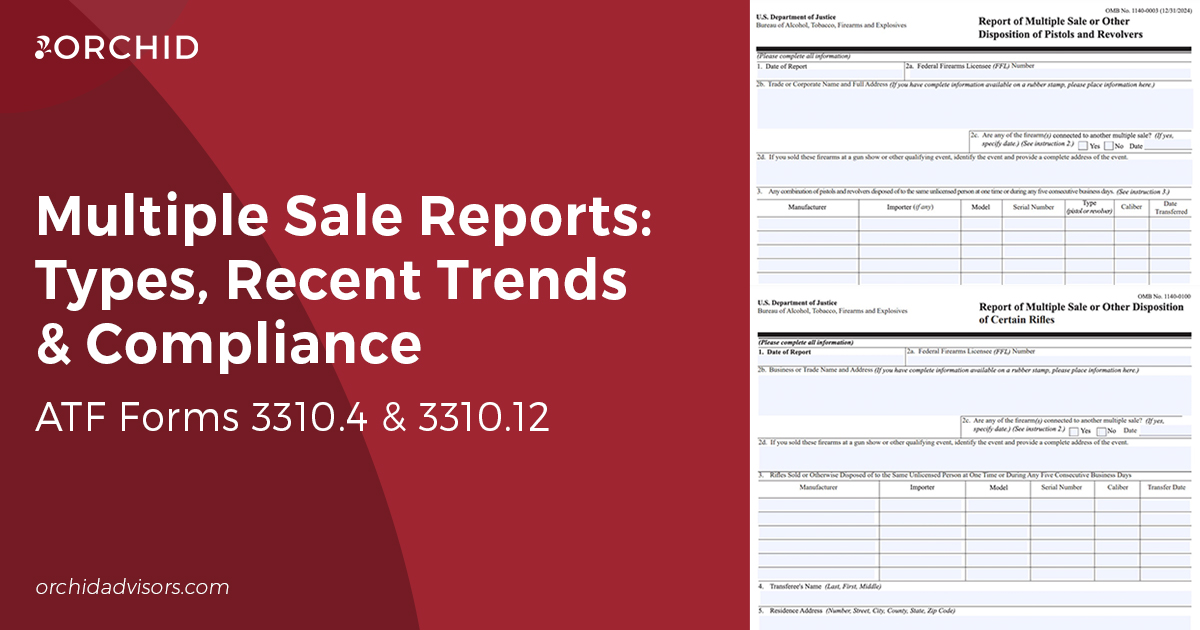In addition to regulating the manufacture, import, sale, and transfer of firearms, the ATF is also responsible for targeting, investigating, and recommending prosecution of those who participate in criminal activities involving firearms – such as firearms trafficking. The act of illegally purchasing, selling, or transferring guns to others within the U.S. or beyond its borders, firearms trafficking often involves large quantities of weapons to be later used in violent crimes.
To combat such activity, and in the interest of public safety, the ATF requires FFLs to report whenever a licensed firearms dealer or pawnbroker disposes of multiple firearms of specific types to unlicensed individuals within a certain period (not including pawn redemptions). If one or more firearms recovered from a crime are found to be part of a multiple purchase, it could be an indicator of firearms trafficking.
Referred to as multiple sale reports (MSRs), below we’ll explain the forms used to report such transactions and review recent trends and data regarding their use.
Types of Multiple Sale Reports
Today, there are two different multiple sale report forms: ATF Form 3310.4, Multiple Sale or Other Disposition of Pistols and Revolvers, and ATF Form 3310.12, Report of Multiple Sale or Other Disposition of Certain Rifles. The differences reflect the type of firearms reported and which FFLs must submit each form.
Sales of Handguns
A provision of the Gun Control Act of 1968, FFLs are required to submit a Form 3310.4 whenever two or more pistols, revolvers, or any combination of pistols and revolvers, are disposed to an unlicensed person at one time or during any five consecutive business days. Completed forms must be faxed, emailed or mailed to the ATF and the local or state Chief Law Enforcement Officer (CLEO) by the close of the business day in which the multiple sale occurred, as well as attached to the completed Firearms Transaction Record (ATF Form 4473) of the sale or transfer.
For example, an individual purchasing three handguns in one transaction on a single day would require the FFL to submit a Form 3310.4. Likewise, an individual purchasing one handgun on Monday and another on Friday of the same week would also require the FFL to submit a Form 3310.4.
Sales of Rifles
Following a covert ATF operation named ‘Fast and Furious,’ in which firearm dealers were encouraged to sell firearms to suspected traffickers of Mexican drug cartels, the agency introduced Demand Letter 3 (DL3) and Form 3310.12, in June 2011. Required of Type 01 and 02 FFLs operating in the Southwest Border States (SWB) of Arizona, California, New Mexico and Texas, FFLs must report multiple sales of specified rifles, including semi-automatic rifles, rifles capable of accepting a detachable magazine, and rifles chambered in a caliber greater than .22, to an unlicensed person at one time or during any five consecutive business days.
Like Forms 3310.4, completed Forms 3310.12 must be faxed, emailed or mailed to the ATF and the local or state CLEO by the close of the business day in which the multiple sale occurred. It’s also recommended the form is attached to the completed Firearms Transaction Record (ATF Form 4473) of the sale or transfer.
A Form 3310.12 is not required for transactions involving receivers for such rifles.
Multiple Sale Report Limitations
While MSRs “produce timely, actionable investigative leads for ATF,” they are not without their limitations. Notably, multiple sale reports only apply to individual FFLs and a person’s purchase or transfer therefrom.
For example, if an individual purchased or transferred one handgun from multiple FFLs within a five-business day period, no Form 3310.4 would be required. Even if each of the FFLs knew that the individual had purchased the handguns, no MSR would be required to be completed or reported.
However, in states like California and Maryland, where residents are restricted by a firearm purchase waiting period, such loopholes are not an issue.
Multiple Sale Report Trends
According to the ATF’s recent “National Firearms Commerce and Trafficking Assessment” report, over 2.5 million multiple sale transactions were completed between 2016–2020, representing 5,840,068 firearms. Of these firearms, only 1.6% (95,314) were rifles.
Between 2016 and 2020, total MSRs and firearms involved in such transactions grew 20% and 19%, respectively, despite multiple sale reports and firearms decreasing 3% and 1% between 2016–2019. This can be explained by the pandemic year of 2020, in which MSRs jumped nearly 29% while firearms involved grew 24%.
During the same five-year period, 10 states – including two SWB states – accounted for 51% of all multiple sale reports and firearms involved, led by Texas (12.1%). The others were Florida, Georgia, Ohio, Pennsylvania, North Carolina, Tennessee, Arizona, Alaska and Virginia. Unsurprisingly, five of these states were also in the top 10 of estimated minimum sales volume (EMSV), or estimate of aggregate firearm sales by FFLs, from 2017–2020.
Among DL3 states, Texas again led in total multiple sale reports (21,567) and rifles involved (50,797), with total DL3 MSRs and firearms decreasing 2016–2018 before increasing from 2019–2020.
Looking at specific firearm calibers and manufacturers, 9mm GLOCK pistols and 5.56 Smith & Wesson rifles were the most associated with MSRs. The top 10 associated handguns included six manufacturers of eight pistols and two revolvers, with 44% of all handguns and 41% of all firearms involved in MSRs chambered in 9mm. The top 10 rifles featured eight manufacturers with 53% of all involved rifles chambered in 2.23/5.56. GLOCK, Heritage Mfg., Ruger, SIG SAUER, Smith & Wesson and Taurus were manufacturers of handguns most associated with Forms 3310.4 while Anderson Manufacturing, Bushmaster, Century Arms, Colt, Diamondback Arms, DPMS, Ruger and Smith & Wesson were most associated with rifles reported on Forms 3310.12.
Multiple Sale Report Compliance
Regulated by the ATF, multiple sale reports are subject to compliance like any other form required of FFLs. In fact, failing to report multiple handgun sales on a Form 3310.4 was the 7th most cited violation by Type 01 and 02 FFLs and the 25th most cited violation of all FFLs during ATF inspections from 2016–2020 with nearly 28,000 instances. But don’t let the numbers fool you into thinking that forgetting to complete or submit an MSR comes without consequence. The ATF states very clearly that such a “willful violation” is basis for revocation.
To prevent violations, FFLs who use electronic, integrated A&D Bound Books and point-of-sale systems, like Orchid eBound™ and POS, can automatically generate completed Forms 3310.4 and 3310.12 to ensure forms are completed and submitted with the utmost compliance.
For more information about multiple sale reports and how retail FFL technology can help your firearms business stay compliant, contact Orchid today to learn about our attorney-backed compliance software and services.







0 Comments